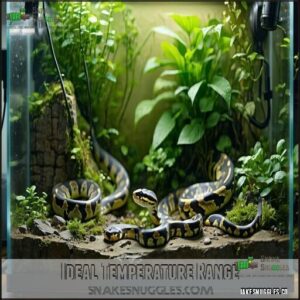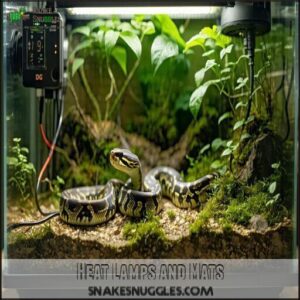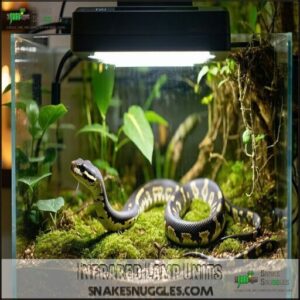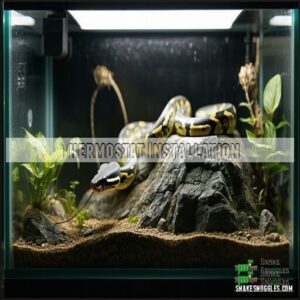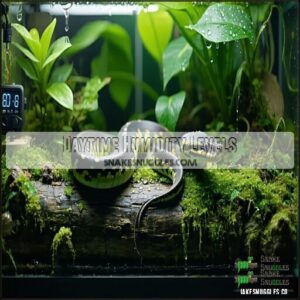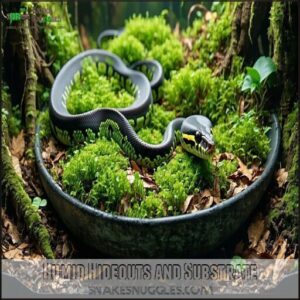This site is supported by our readers. We may earn a commission, at no cost to you, if you purchase through links.
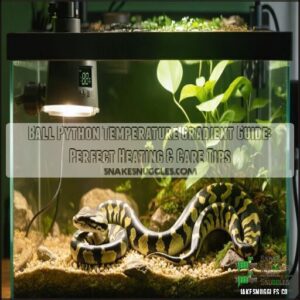
You’ll need to maintain this difference across the enclosure to allow your snake to thermoregulate naturally.
Position heating elements like UTH or CHE on one side only, and always use a thermostat to prevent burns.
Monitor temperatures daily with reliable digital thermometers at both ends and the middle of the enclosure.
Remember, proper temperature gradients aren’t just comfort—they’re essential for digestion, immune function, and activity levels.
The right setup means your snake can be its own temperature control expert, just like in the wild.
Table Of Contents
- Key Takeaways
- Ball Python Temperature
- Ideal Temperature Range
- Heating Setup Guide
- Humidity Requirements
- Temperature Regulation
- Frequently Asked Questions (FAQs)
- What temperature gradient for ball python enclosure?
- Can you leave a heat lamp on 24/7 for ball python?
- Is 78 too cold for a ball python?
- Temperature impact during brumation periods?
- Power outage temperature emergency protocols?
- Travel container temperature maintenance tips?
- Temperature needs during quarantine?
- Seasonal temperature adjustments necessary?
- Conclusion
Key Takeaways
- You’ll need to maintain a temperature gradient with a warm side (88-92°F) and cool side (75-80°F), allowing your ball python to thermoregulate naturally just like in the wild.
- Always use a thermostat with your heating elements (UTH, CHE, or heat lamps) to prevent burns and monitor temperatures daily with reliable digital thermometers at both ends of the enclosure.
- You should create specific temperature zones including a basking spot (90-95°F), warm hide (86-90°F), and cool hide (72-80°F) to support your snake’s digestion, immune function, and activity levels.
- Don’t forget to slightly lower nighttime temperatures (75-80°F) to mimic your ball python’s natural habitat, which supports healthy metabolic cycles and proper rest.
Ball Python Temperature
Maintaining the right temperature gradient is essential for your ball python’s health, as they rely on external heat sources to regulate their body functions.
Here’s a blockquote that captures the essence of temperature’s importance for ball pythons in an engaging way:
External heat isn’t just comfort for ball pythons—it’s their metabolic engine and the key to their survival.
By creating zones with specific temperatures, you’ll help them digest food, stay active, and thrive in their enclosure, which is crucial for their overall well-being and relies on the right temperature.
Basking Surface Temperature
The basking surface is your ball python’s hot spot, essential for digestion and activity.
Keep the ideal range at 90-95°F using a heat lamp. Verify the bulb distance prevents burns, and use a thermometer or infrared temperature gun for accuracy.
Choose a surface material that retains heat evenly, and monitor regularly to maintain the python temperature gradient safely.
Warm Hide Temperature
Your ball python’s warm hide should stay between 86-90°F. This area mimics a cozy retreat, aiding digestion and comfort.
Use a thermostat to maintain python temperature gradients. Proper humidity levels are also essential for healthy shedding.
Here’s how to optimize it:
- Pick a snug hide size for security.
- Use heat mats beneath the enclosure.
- Monitor with a reliable thermometer.
- Choose insulating hide materials.
Cool Hide Temperature
Your cool hide should stay between 72-80°F, offering a safe retreat within the ball python temperature gradient.
Location matters—place it on the enclosure’s cooler side. Use insulating materials like cork or plastic, as size matters for comfort.
Monitoring tools like thermometers guarantee accuracy. For alternative cooling, adjust ambient room temperatures to maintain the ideal temperature range, matching your python’s preferences.
Nighttime Temperature
At night, the ball python temperature should drop slightly to mimic its natural habitat.
This drop supports healthy metabolic cycles and rest.
Use heating methods like ceramic heat emitters or radiant panels to maintain consistency, aiming for a nighttime temperature range of 75-80°F, allowing your snake to experience a gentle temperature gradient, and avoid excessive cooling, as improper temperature drops can impact health.
Ideal Temperature Range
Maintaining the right temperature range is essential for your ball python’s health and behavior.
Aim for a daytime gradient of 80-85°F with a nighttime drop to 75-80°F to mimic their natural environment.
Daytime Temperature Requirements
During the day, maintain an ideal range of 80-85°F in your ball python’s enclosure.
A basking spot should hit 88-92°F to support digestion and natural basking behavior.
Place heating elements strategically to create a clear temperature gradient.
Use reliable monitoring tools to guarantee consistent ball python temperature levels, as improper ranges can disrupt activity and digestion impact.
Nighttime Temperature Requirements
As the sun sets, your ball python’s nighttime temperature should safely drop within 75-80°F.
This mimics natural seasonal variation and keeps them comfortable.
Use a thermostat to maintain safe ranges.
Here’s how to guarantee proper nighttime heating:
- Set thermostat settings to 75°F minimum.
- Add ceramic heat emitters for warmth.
- Monitor with thermometers.
- Avoid drastic temperature drops.
Ambient Temperature Control
Your ball python’s enclosure placement plays a big role in maintaining proper ambient temperature.
Keep the room temperature steady, around 75-82°F, and avoid drafts.
Use insulation methods like foam boards to retain heat.
Backup heating guarantees stability during cold spells.
Temperature probes help monitor the gradient, facilitating effective reptile temperature control.
Consistent ambient temperature supports digestion, comfort, and overall health.
Heating Setup Guide
Creating the right heating setup is essential for maintaining your ball python’s health and comfort.
By combining tools like heat lamps, mats, and thermostats, you can establish a proper thermal gradient that mimics their natural environment.
Heat Lamps and Mats
When setting up heat lamps and mats, focus on creating a safe, effective gradient.
Follow these steps:
- Use appropriate lamp wattage for basking spots.
- Place heat mats under one side for localized warmth.
- Always connect heating elements to a thermostat for control.
To guarantee proper heating, consider specific heat product needs.
- Avoid burning risks by using guards on lamps.
- Monitor temperatures with thermometers regularly.
Radiant Heat Panels
Radiant heat panels are a game-changer for reptile temperature control.
They provide widespread warmth, ensuring a stable temperature gradient.
Mounted on the ceiling, they offer broad heat coverage and their energy efficiency and safety features make them ideal for large enclosures.
Choose the right size for effective heating, and always pair with a thermostat for precision.
Here’s a quick comparison:
| Feature | Benefit | Tip |
|---|---|---|
| Panel Installation | Broad heat coverage | Mount lengthwise for balance |
| Size Selection | Matches enclosure size | Use 40W or 80W appropriately |
| Safety Features | Low fire risk | Inspect wiring regularly |
Their energy efficiency and safety features are key benefits, making them a reliable choice for reptile enclosures.
Infrared Lamp Units
Infrared lamp units are excellent for providing deep heat penetration through infrared radiation, especially within the infrared spectrum.
These heat lamps mimic natural sunlight without disrupting your python’s day/night rhythm.
Look for energy-efficient options like halogen heating or deep heat projectors.
Always check bulb lifespan and follow safety measures, using a thermostat to maintain stable infrared wavelengths and enclosure temperatures.
For maximum safety, consider ceramic heat emitters as an alternative.
Thermostat Installation
Using a thermostat guarantees precise temperature control for your ball python’s enclosure. Place the probe inside the warm hide where your python resides, not directly on heating elements.
Calibrate thermostats regularly for accuracy and use safety features to prevent overheating. For superior performance, consider reliable thermostat options.
- Probe Placement: Position it at your snake’s level.
- Thermostat Calibration: Check settings often.
- Safety Features: Use backups for reliability.
Humidity Requirements
Maintaining the right humidity levels is essential for your ball python’s health.
Aiding in proper shedding and hydration, you’ll need to monitor and adjust daily to replicate their natural environment effectively.
Daytime Humidity Levels
During the day, keep humidity levels between 60-80% to support respiratory health and proper hydration.
Use humidity probes for accurate measurement, ensuring consistent humidity control. Stable humidity is essential for shedding humidity needs, helping prevent stuck sheds.
Good enclosure ventilation prevents excess moisture buildup, while proper humidity maintenance keeps your ball python comfortable and healthy.
You can maintain this humidity with appropriate substrate choices, which is crucial for proper hydration and supports overall ball python care.
Nighttime Humidity Levels
Nighttime humidity levels for ball pythons should increase to 80-100%, mimicking their natural African habitat.
This higher nighttime humidity supports proper shedding success and respiratory health.
You’ll notice slight condensation on enclosure walls, which is normal, but watch for excessive moisture that could lead to mold.
Maintaining this humidity-temperature balance is especially important when nighttime temperatures drop to the 75-78°F range, which is crucial for their respiratory health.
Humid Hideouts and Substrate
Humid hideouts lined with sphagnum moss provide essential microenvironments for your ball python’s hydration needs.
To create effective humid retreats, select moisture-retentive substrate with a minimum 4-inch depth throughout the enclosure.
Position at least two hideouts—one on the cool side and another in the middle—and refresh moss regularly for mold prevention.
The substrate choice directly impacts your humidity gradient, with coconut fiber or cypress mulch offering excellent moisture retention while maintaining proper airflow.
Daily Misting and Monitoring
While proper substrate creates the foundation for humidity, daily misting and monitoring are your ongoing responsibilities.
Spray your enclosure 1-2 times daily with room temperature water, targeting decorations and substrate rather than your ball python directly.
Place a digital thermometer-hygrometer in both warm and cool areas to track humidity levels.
Watch for humidity spikes after misting and make certain adequate ventilation to prevent mold growth.
Temperature Regulation
You’ll need to maintain precise temperature regulation in your ball python’s enclosure by considering factors like cage size, substrate type, ambient room temperature, and your snake’s age.
Proper selection of heating elements and accurate thermometers guarantees your snake can thermoregulate effectively, preventing health issues while supporting essential metabolic functions.
Enclosure Size and Temperature
The right enclosure size directly affects your ball python’s temperature gradient effectiveness.
Larger enclosures make maintaining proper heat distribution more challenging, while smaller ones may create inadequate temperature zones.
For proper python temperature maintenance in your enclosure, use at least a 40-gallon tank for adult ball pythons to guarantee sufficient thermal gradient.
- Position heat sources to maintain a 10-15°F difference between warm and cool sides
- Adjust basking distance based on enclosure volume (8-12 inches for 40-gallon tanks)
Substrate and Ambient Room Temperature
Your substrate choice directly affects your ball python’s temperature gradient.
Deeper substrates like coconut husk or cypress mulch provide better thermal inertia, maintaining stable temperatures throughout the day.
The ambient room temperature also impacts your enclosure – rooms below 70°F will make heating more challenging.
Use insulation methods around the tank sides to help maintain your temperature range, especially around the cool hide where burrowing behavior occurs.
Age and Size of Ball Python
Your ball python’s age and size directly impact its temperature needs.
Young pythons grow rapidly, doubling in length during their first year, and require slightly higher temperatures for proper digestion.
As they mature toward their adult size of 3-4 feet by age three, you’ll need to adjust their temperature gradient accordingly.
Larger pythons generate more body heat but still need appropriate warm and cool zones for effective thermoregulation.
To maintain ideal health, remember to monitor the basking spot temperature closely, focusing on the overall health of your pet.
Selecting Heating Elements and Thermometers
While your ball python’s age and size influence temperature needs, choosing the right equipment is equally important.
Select heating elements based on their lifespan and safety features. Heat mats require thermostats like the budget-friendly Inkbird or premium Herpstat 1 to prevent burns.
You can find a suitable thermostat here for your setup.
For ideal python temperature monitoring, pair infrared thermometers for surface readings with digital probes for ambient measurements.
Regular thermostat calibration guarantees accurate readings within the proper snake temperature range, ensuring a safe environment through proper snake temperature and accurate readings.
Frequently Asked Questions (FAQs)
What temperature gradient for ball python enclosure?
Like a perfect dance of warmth, your ball python needs 88-92°F on the warm side, 75-80°F on the cool side, with ambient temperature around 82°F.
You’ll need a basking spot of 90-95°F.
Can you leave a heat lamp on 24/7 for ball python?
No, don’t leave a heat lamp on 24/7 for your ball python. They need a day-night cycle with temperatures that drop at night. Use a thermostat and timer for proper regulation.
Is 78 too cold for a ball python?
At 78°F, you’re at the lower end of acceptable temperatures for your ball python.
It’s not immediately dangerous, but you’ll want warmer areas available in the enclosure for proper digestion and activity.
Temperature impact during brumation periods?
During brumation, you’ll need to gradually lower your ball python’s temperature to 75°F (24°C).
This natural cooling period affects metabolism, reducing activity and appetite while supporting normal hormone cycles and breeding behaviors, which is crucial for the snake’s overall health and breeding.
Power outage temperature emergency protocols?
During power outages, insulate your snake’s enclosure with blankets, use reptile-specific heat packs (not human hand warmers), or create body heat by placing your python in a secure pillowcase against your skin.
Never let temperatures drop below 70°F.
Travel container temperature maintenance tips?
For travel containers, maintain 75-85°F using heat packs wrapped in cloth. Place digital thermometers inside to monitor conditions. You’ll need separate cool and warm zones even during transportation.
Temperature needs during quarantine?
During quarantine, maintain a temperature gradient of 75-85°F with a basking spot around 90°F.
Use thermostats and reliable thermometers to monitor.
Keep conditions stable to reduce stress and support digestion and immune health.
Seasonal temperature adjustments necessary?
You’ll need to make slight temperature adjustments seasonally.
Lower temperatures by 3-5°F during winter months to mimic natural cycles, which supports your ball python’s biological rhythms and may enhance breeding success.
This adjustment is crucial as it helps in maintaining the natural environment for your ball python.
Conclusion
As clear as a desert sunrise, mastering this ball python temperature gradient guide will transform you from novice to confident keeper.
You’ll create an environment where your snake thrives, not just survives.
Remember to check temperatures daily, maintain that essential warm-to-cool differential, and always use a thermostat with heating elements.
When you nail the perfect temperature gradient, you’re rewarding your ball python with better digestion, stronger immunity, and natural behavior patterns they’d experience in the wild, thanks to a well-designed temperature gradient that supports better digestion.


